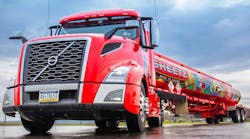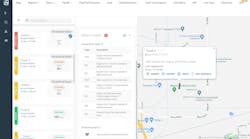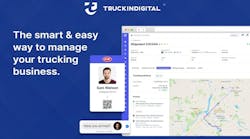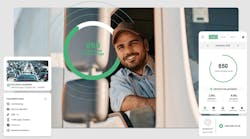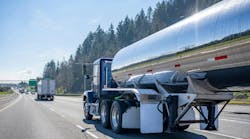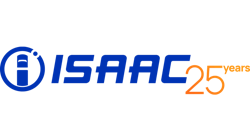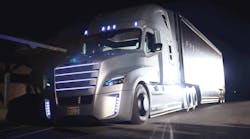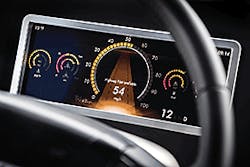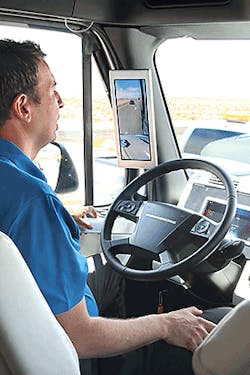When the Freightliner unit of Daimler Trucks North America (DTNA) began planning the official announcement that the Freightliner Inspiration tractor had qualified for the first autonomous truck license in the United States, company officials decided to go big. They wanted to make sure it was a truly momentous event, and they succeeded.
Hundreds of media representatives from 22 countries were brought in to cover the May 5-6 event. Proceedings started with the presentation of Nevada’s first registration and license plate at the Las Vegas (Nevada) Motor Speedway followed by an evening multi-media event in which the Hoover Dam was turned into the largest projection screen in North America.
All of this was to spotlight the Freightliner Inspiration test truck with Daimler’s Highway Pilot control system. Daimler officials call the self-driving heavy-duty truck the future of the trucking industry, but they acknowledge that it will be years before an autonomous truck hits the highway for anything more than tests and demonstrations.
“This is an example of Freightliner shaping transportation with new technology, efficiency, and safety,” said Martin Daum, DTNA president and chief executive officer. “Freightliner Trucks has infinite inspiration when it comes to improving Real Cost of Ownership for our customers. The Freightliner Inspiration Truck is the latest example of how we meet the challenges faced by our customers through innovation.”
Wolfgang Bernhard, member of the board of management of Daimler AG Daimler Trucks and Buses, added: “The autonomous vehicle technology we are showcasing in the Freightliner Inspiration Truck will help reduce accidents, improve fuel consumption, cut highway congestion, and safeguard the environment. Daimler Trucks North America is committed to developing the latest technology to meet our customers’ needs and delivering the best commercial trucks in the world. We are proud to get this vehicle on the road today. We selected Nevada for the Freightliner Inspiration because it is one of only four states that require special licensing. Our goal was to not only showcase what was technologically possible, but to do it in a regulated environment with safety standards and other oversight requirements.”
The State of Nevada was represented by Governor Brian Sandoval, who presented the state’s first license plate for an autonomous vehicle. “Nevada is proud to be making transportation history by hosting the first US public highway drive for a licensed autonomous commercial truck. The application of this innovative technology to one of America’s most important industries will have a lasting impact on our state and help shape the New Nevada economy. The Nevada Department of Motor Vehicles has been closely monitoring the advancements being made in autonomous vehicle development and reviewed DTNA’s safety, testing, and training plans before granting permission for this demonstration of the Freightliner Inspiration Truck.”
In July 2014, Daimler Trucks provided the world's first demonstration of an autonomous truck in action when the Mercedes-Benz Future Truck 2025 drove along a cordoned-off section of the A14 autobahn near Magdeburg, Germany. The Inspiration Truck is now the next step on the road to series production of the Highway Pilot system. The development engineers of Daimler Trucks transferred the system to the US Freightliner brand and modified it for use on US highways.
The result: the State of Nevada certified no less than two Freightliner Inspiration Trucks for regular operations on public roads. The Freightliner Inspiration Truck is based on the series-produced US Freightliner Cascadia model, but with the addition of the Highway Pilot technology. The latter comprises the front bumper-mounted radar and a stereo camera plus tried and tested assistance systems such as Adaptive Cruise Control, as seen in the standard Freightliner Cascadia models and the Mercedes-Benz Actros. For licensing on public roads in Nevada, the technology was further developed and the precise interaction of components extensively tested. As part of the truck´s so-called Marathon Run, the Freightliner Inspiration Truck covered over 10,000 miles (over 16,000 kilometers) on a test circuit in Papenburg, Germany.
The system developed at Daimler is similar in function to the autopilot in an airliner. As soon as the Freightliner Inspiration Truck is safely on the highway, the driver can activate the Highway Pilot system. The driver receives a visual prompt in the instrument cluster to activate the "Highway Pilot." The vehicle switches to autonomous mode and adapts to the speed of traffic. The driver receives a confirmation message in the instrument cluster, "Highway Pilot active."
The Highway Pilot system uses a complex stereo camera and radar systems with lane-keeping and collision-prevention functions. It regulates the speed, applies the brakes and steers. This combination of systems creates an autonomous vehicle that can operate safely under a wide range of driving conditions--the truck automatically complies with posted speed limits, regulates the distance from the vehicle ahead or uses the stop-and-go function during rush hour.
However, the system does not initiate autonomous passing maneuvers. These have to be executed by the driver. The same is true for leaving the highway and changing lanes. Via the user interface, the Highway Pilot keeps the driver visually informed about its current status and accepts instructions. The driver can deactivate the Highway Pilot manually and is able to override the system at any time. If the vehicle is no longer able to process crucial aspects of its environment, such as road construction zones or bad weather, the driver is prompted to retake control. In addition to a visual prompt in the instrument cluster there is also a subsequent audible notification.
A radar unit centered in the front bumper of the Freightliner Inspiration Truck monitors the road at close and long range. The long-range sensor goes out to about 820 feet (250 meters) at an aperture angle of 18 degrees and detects vehicles in a long and narrow area. The short-range sensor goes out to about 230 feet (70 meters) at an aperture angle of 130 degrees and detects vehicles in a wider area that could merge into the lane in front of the truck. The front radar unit forms the basis for the Adaptive Cruise Control system and the Active Brake Assist system, which are already familiar from the Mercedes-Benz Actros and the Detroit Assurance series of safety systems in the series production model of the Freightliner Cascadia Evolution.
The area in front of the truck is also monitored by a stereo camera mounted above the dashboard on the inside of the windshield. The camera has a range of about 100 meters (328 feet) and aperture angles of 45 degrees horizontally and 27 degrees vertically. The camera recognizes pavement markings and communicates with the steering gear of the Highway Pilot system to keep the truck in its lane autonomously.
The Adaptive Cruise Control system of the Freightliner Inspiration Truck uses the same hardware and software as the series production variants of the Mercedes-Benz Actros and Freightliner Cascadia Evolution. The system receives the same input signals within the identical range of values and comprises the same functions and safety features. The use of the standard system ensures that the acceleration and braking maneuvers controlled by the Highway Pilot system are always within the limits of the production vehicle. The active power steering system uses the same hardware as production vehicles, however, the software has been modified. The system offers the same functions and safety features as the system in the series production vehicle.
The steering gear installed in the Freightliner Inspiration Truck has already been proven on the road in Mercedes-Benz trucks since 2011. The camera of the Lane Keeping Assist system has already completed more than 50,000 miles (80,000 kilometers) of testing and has been used in all Mercedes-Benz Advanced Engineering projects since 2008. Testing of the front radar unit began in 2008 and since then it has successfully completed more than two million miles (three million kilometers) in series production and in tests at Mercedes-Benz Cars and Daimler Trucks.
Inspiration Truck has its own distinctive design, which is dominated by a hood that overlaps the usual radiator grille. The hood can be pushed forward and tilted for opening. The door skins are shaped to perfectly blend with the lines of the front end. The side panels were redesigned to form a single unit with the hood and the wheel arches. The wheel arches themselves have been optimized aerodynamically and have a dynamic design.
The exterior lighting of the Inspiration Truck is a true eye-catcher and completely new: the license plate, indicators and the radiator grille shine blue as soon as the vehicle is in autonomous mode, and white and yellow while in standard operation. The unusual headlamps continue the design idiom of the hood.
A special feature inside is the use of bench seats, which were installed specifically for the driving event of the Freightliner Inspiration Truck premiere. In addition, halogen lighting in the interior creates a pleasant, cozy atmosphere.
After the Cascadia Evolution Truck and the SuperTruck, the Inspiration Truck represents the third demonstration of the consistent way in which the Freightliner Trucks technology strategy has developed in the United States. As a global commercial vehicle manufacturer Daimler is demonstrating how intelligent technologies can be rolled out across Group brands within the shortest time frame. Daimler Trucks’ worldwide platform strategy in particular allows economies of scale to be made.
In terms of on-highway commercial trucks, it is incorrect to refer to a vehicle in autonomous mode as a driverless truck. A driver remains in control of his vehicle because the technology requires the presence of a qualified truck driver with valid commercial driver's license. The driver is an important part of the system and must remain in control of the truck in certain traffic situations on the highway and on country roads, in city traffic, and when hooking up a trailer or making deliveries.
Autonomous driving relieves drivers from tiring and often monotonous long-distance routes, according to Daimler officials. The autonomously driven truck also should increase fuel efficiency, improve traffic safety, and reduce CO2 emissions.
Tests by Mercedes-Benz and Freightliner Trucks indicate that autonomous driving will cut fuel consumption by up to 5%. This data was corroborated by a recent Frost & Sullivan study, which found that an autonomously driven heavy-duty truck could achieve a savings potential of up to 7% on average, while fuel consumption in regional transport would be reduced by 4%. ♦
